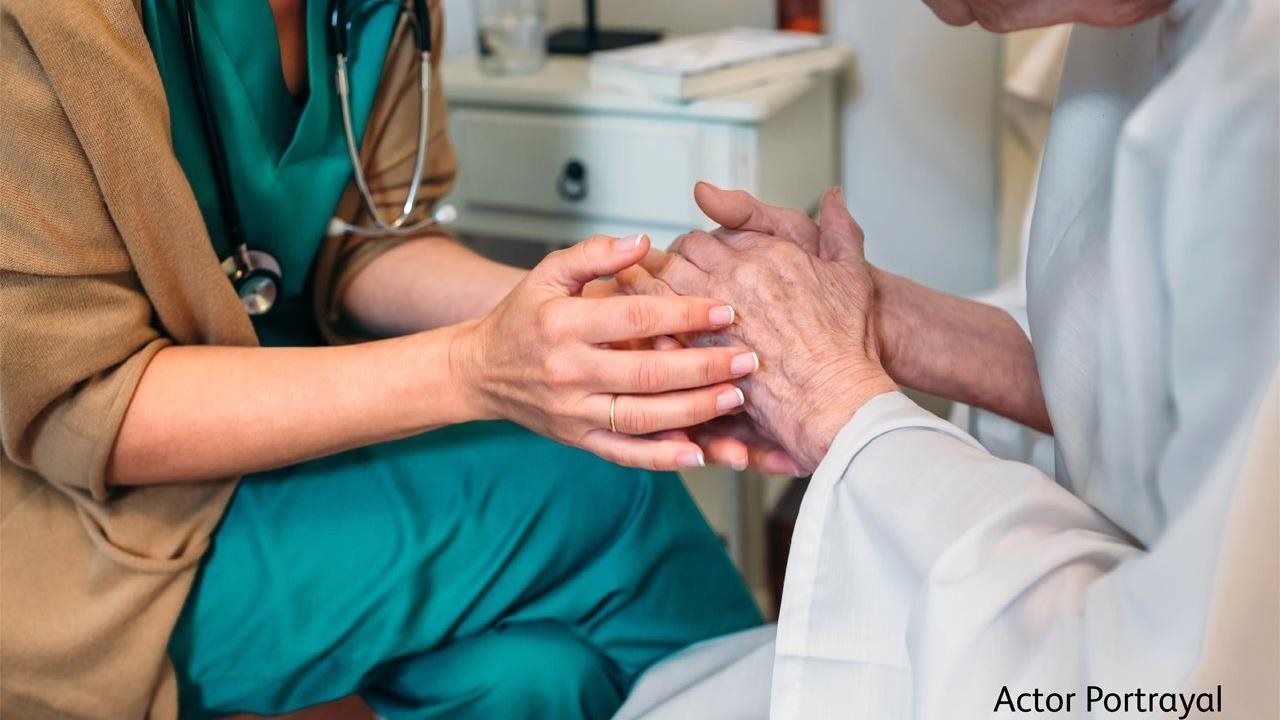2025-01-22T09:31:00
(BPT) – Knowledge is one of the most valuable tools when faced with a cancer diagnosis. Given that one in two men and one in three women are expected to be diagnosed with some form of cancer during their lifetimes, it’s hard to ignore how important knowledge is when understanding a diagnosis and deciding the appropriate path forward. This remains true for renal cell carcinoma, or RCC. While some people with kidney cancer may experience symptoms, like blood in urine, lower back pain on one side, and a mass on the side or lower back, others may only have limited symptoms such as mild hip pain.
When people experience pain or symptoms that are out of the ordinary, it is recommended that they visit their healthcare provider, who may recommend further testing.
In certain cases, if testing or imaging reveal metastatic cancer, meaning cancer that has spread to other parts of the body from where it originated, a strong, trusting relationship between a patient and their healthcare provider is key to understanding treatment options and deciding the appropriate plan of care. For certain patients with advanced RCC, a dual immunotherapy treatment may be an option.
What might a person expect when diagnosed with advanced RCC?
Hearing “you have cancer” can feel overwhelming. Treatment decisions may need to happen quickly and it’s natural to have questions. When facing an advanced RCC diagnosis, information is power, and getting the details can be very helpful to feel more prepared to move forward.
For those recently diagnosed, it is recommended to ask the following questions:
- What type of kidney cancer do I have?
- Has the cancer spread?
- What stage is the cancer, and what does that mean?
- Where can patients find resources and support?
- What are the treatment options?
- What should someone expect when undergoing treatment?
It is important to feel empowered when facing advanced RCC, and this empowerment can be grounded in a patient’s relationship with and communication with their doctor. Discussions about treatment should be a shared decision-making process.
What types of treatments are available for people facing an advanced RCC diagnosis?
There are several treatment options for advanced RCC. Immunotherapy is a treatment option that is designed to work with the body’s immune system to help fight cancer. For eligible people, dual immunotherapy — which is a combination of two immunotherapy treatments — may be recommended.
An example of dual immunotherapy is Opdivo® (or nivolumab) plus Yervoy® (or ipilimumab), which are approved by the U.S. Food and Drug Administration for certain newly diagnosed adults whose kidney cancer has spread and have not already had treatment for advanced RCC. It is the first and only combination of two immunotherapies of its kind approved to treat advanced RCC.
Opdivo plus Yervoy is designed to work by helping your immune system to fight cancer. These two immunotherapies work in different but complementary ways.
It’s also important to understand that while doing so, this immunotherapy combination can also affect healthy cells in any area of your body. These problems can sometimes become serious or life-threatening and can lead to death. These problems may happen anytime during treatment or even after treatment has ended. You may have more than one of these problems at the same time. Some of these problems may happen more often when Opdivo is used in combination with Yervoy.
Serious side effects may include lung problems; intestinal problems; liver problems; hormone gland problems; kidney problems; skin problems; eye problems; problems in other organs and tissues; severe infusion reactions; and complications of stem cell transplant, including graft-versus-host disease (GVHD), that uses donor stem cells (or allogeneic). Call or see your healthcare provider right away for any new or worsening signs or symptoms. Additional Important Safety Information is below.
What other information may be helpful for those facing an advanced RCC diagnosis?
Having a network to rely on and having support through the process is very important. A family member or a friend sitting in a waiting room can help provide support and encouragement.
To learn more about Opdivo + Yervoy, please visit Opdivo.com.
Indication
OPDIVO® (nivolumab) is a prescription medicine used in combination with YERVOY® (ipilimumab) as a first treatment for certain adults with kidney cancer that has spread (advanced renal cell carcinoma).
It is not known if OPDIVO is safe and effective in children younger than 12 years of age with melanoma or MSI-H or dMMR metastatic colorectal cancer.
It is not known if OPDIVO is safe and effective in children for the treatment of any other cancers.
Important Safety Information for OPDIVO® (nivolumab) + YERVOY® (ipilimumab)
What is the most important information I should know about OPDIVO + YERVOY?
OPDIVO and YERVOY are medicines that may treat certain cancers by working with your immune system. OPDIVO and YERVOY can cause your immune system to attack normal organs and tissues in any area of your body and can affect the way they work. These problems can sometimes become severe or life-threatening and can lead to death. These problems may happen anytime during treatment or even after your treatment has ended. You may have more than one of these problems at the same time. Some of these problems may happen more often when OPDIVO is used in combination with another therapy.
Call or see your healthcare provider right away if you develop any new or worse signs or symptoms, including:
- Lung problems: cough; shortness of breath; chest pain
- Intestinal problems: diarrhea (loose stools) or more frequent bowel movements than usual; stools that are black, tarry, sticky, or have blood or mucus; severe stomach-area (abdominal) pain or tenderness
- Liver problems: yellowing of your skin or the whites of your eyes; severe nausea or vomiting; pain on the right side of your stomach area (abdomen); dark urine (tea colored); bleeding or bruising more easily than normal
- Hormone gland problems: headaches that will not go away or unusual headaches; eye sensitivity to light; eye problems; rapid heart beat; increased sweating; extreme tiredness; weight gain or weight loss; feeling more hungry or thirsty than usual; urinating more often than usual; hair loss; feeling cold; constipation; your voice gets deeper; dizziness or fainting; changes in mood or behavior, such as decreased sex drive, irritability, or forgetfulness
- Kidney problems: decrease in your amount of urine; blood in your urine; swelling in your ankles; loss of appetite
- Skin problems: rash; itching; skin blistering or peeling; swollen lymph nodes; painful sores or ulcers in the mouth or nose, throat, or genital area; fever or flu-like symptoms
- Eye problems: blurry vision, double vision, or other vision problems; eye pain or redness.
Rejection of a transplanted organ or tissue. Your healthcare provider should tell you what signs and symptoms you should report and monitor you depending on the type of organ transplant that you have had.
Problems can also happen in other organs and tissues. These are not all of the signs and symptoms of immune system problems that can happen with OPDIVO and YERVOY. Call or see your healthcare provider right away for any new or worsening signs or symptoms, which may include:
- Chest pain; irregular heartbeat; shortness of breath; swelling of ankles
- Confusion; sleepiness; memory problems; changes in mood or behavior; stiff neck; balance problems; tingling or numbness of the arms or legs
- Double vision; blurry vision; sensitivity to light; eye pain; changes in eye sight
- Persistent or severe muscle pain or weakness; muscle cramps
- Low red blood cells; bruising
Rejection of a transplanted organ or tissue. Your healthcare provider should tell you what signs and symptoms you should report and monitor you depending on the type of organ transplant that you have had.
Getting medical help right away may help keep these problems from becoming more serious. Your healthcare team will check you for these problems during treatment and may treat you with corticosteroid or hormone replacement medicines. Your healthcare team may also need to delay or completely stop your treatment if you have severe side effects.
Possible side effects of OPDIVO + YERVOY
OPDIVO and OPDIVO + YERVOY can cause serious side effects, including:
- See “What is the most important information I should know about OPDIVO + YERVOY?”
- Severe infusion reactions. Tell your healthcare team right away if you get these symptoms during an infusion of OPDIVO or YERVOY: chills or shaking; itching or rash; flushing; shortness of breath or wheezing; dizziness; feel like passing out; fever; back or neck pain
- Complications, including graft-versus-host disease (GVHD), of bone marrow (stem cell) transplant that uses donor stem cells (allogeneic). These complications can be severe and can lead to death. These complications may happen if you underwent transplantation either before or after being treated with OPDIVO or YERVOY. Your healthcare provider will monitor you for these complications.
The most common side effects of OPDIVO, when used in combination with YERVOY, include: feeling tired; diarrhea; rash; itching; nausea; pain in muscles, bones, and joints; fever; cough; decreased appetite; vomiting; stomach-area (abdominal) pain; shortness of breath; upper respiratory tract infection; headache; low thyroid hormone levels (hypothyroidism); constipation; decreased weight; and dizziness.
These are not all the possible side effects. For more information, ask your healthcare provider or pharmacist. You are encouraged to report side effects of prescription drugs to the FDA. Call 1-800-FDA-1088.
Before receiving OPDIVO or YERVOY, tell your healthcare provider about all of your medical conditions, including if you:
- have immune system problems such as Crohn’s disease, ulcerative colitis, or lupus
- have received an organ transplant, including corneal transplant
- have received or plan to receive a stem cell transplant that uses donor stem cells (allogeneic)
- have received radiation treatment to your chest area in the past and have received other medicines that are like OPDIVO
- have a condition that affects your nervous system, such as myasthenia gravis or Guillain-Barré syndrome
- are pregnant or plan to become pregnant. OPDIVO and YERVOY can harm your unborn baby.
- are breastfeeding or plan to breastfeed. It is not known if OPDIVO or YERVOY passes into your breast milk. Do not breastfeed during treatment with OPDIVO or YERVOY and for 5 months after the last dose of OPDIVO or YERVOY.
Females who are able to become pregnant:
Your healthcare provider should do a pregnancy test before you start receiving OPDIVO or YERVOY.
- You should use an effective method of birth control during your treatment and for 5 months after the last dose of OPDIVO or YERVOY. Talk to your healthcare provider about birth control methods that you can use during this time.
- Tell your healthcare provider right away if you become pregnant or think you may be pregnant during treatment with OPDIVO or YERVOY. You or your healthcare provider should contact
Bristol-Myers Squibb at 1- 844-593-7869 as soon as you become aware of a pregnancy.
Tell your healthcare provider about all the medicines you take, including prescription and over-the- counter medicines, vitamins, and herbal supplements.
Please see U.S. Full Prescribing Information and Medication Guide for OPDIVO and YERVOY.
© 2025 Bristol-Myers Squibb Company.
OPDIVO®, YERVOY® and the related logos are registered trademarks of Bristol-Myers Squibb Company.
7356-US02400311 1/25


























